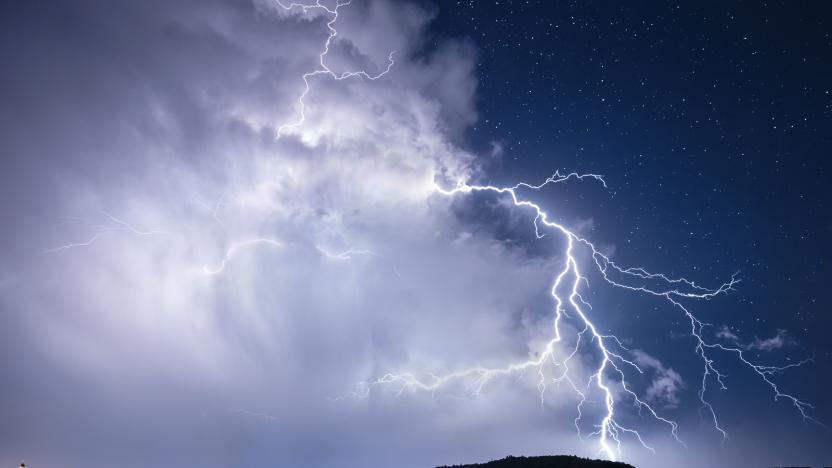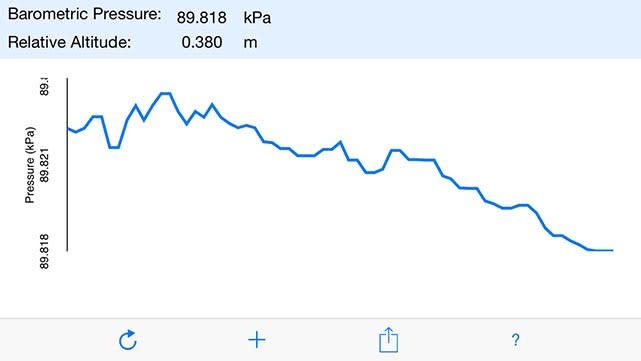barometer
Latest

IBM is turning to your smartphone to improve weather forecasts
IBM and its subsidiary The Weather Company are working on a new weather forecasting system, one that they say will boost forecast accuracy quite a bit. It's called the Global High-Resolution Atmospheric Forecasting System, or GRAF, and it will pull data from weather stations, aircraft sensors and smartphone pressure sensors -- a massive amount of information that will be analyzed by the IBM technology that powers the US Department of Energy's powerful Summit and Sierra supercomputers.

Dark Sky uses your iPhone's sensors to improve weather forecasts
Your iPhone gives you weather forecasts right from the get-go, but it's now ready to shape those forecasts as well. Dark Sky has given its iOS app a big overhaul that, if you like, uses the barometer on your iPhone 6 or 6 Plus to contribute pressure readings. The hope is that these will dramatically improve short-term forecasts in the future -- you'll know that it's about to rain because iPhones nearby gave you a heads-up. There have been apps that crowdsourced pressure data before, but rarely with the intent to directly improve forecasts -- and not on the scale of Dark Sky, one of iOS' best-known weather tools.

Pressur is a simple barometer app
The iPhone 6, 6 plus and the iPad Air 2 added a barometer sensor. Ostensibly it is supposed to help the device better track your steps for the health app by knowing when you've gone up and down stairs. But there is no reason it can't also be used for weather purposes. That's exactly what Pressur does. It reads the data from the sensor and displays it on your screen. The app is simple enough. The main screen shows you the current reading. And the Log shows you a list of the most recent readings. I haven't completely figured out how they are supposed to work. Sometimes I see a lot of recent readings and sometimes it acts like I've just run it for the first time and it only shows me the most recent one. So, often the Trends diagram only shows me one or two data points making for a very boring graph. The app offers an in-app purchase to remove ads and adds some additional options (and maybe the ability to track more than a few data points?). It also allows you to add a trend graph as a Today widget. Pressur is a free app with ads or $0.99 to remove ads as an in-app purchase. It requires the iPhone 6, iPhone 6 Plus, or an iPad Air 2 and iOS 8 and up.

Barograph uses the new iPhone pressure sensor
The new iPhone 6 and 6 Plus each have a sensor that gives readings for barometric pressure. Barograph (free), displays real-time pressure data from that sensor. Weather watchers will know dropping pressure usually means bad weather is coming, rising pressure means good weather. The app's main interface is a graph that looks for very small changes. Initially it might seem uneven, but you can usually spot a trend pretty easily. The app charts the pressure and your relative altitude. If you leave the app or lock your phone, the readings stop after 30 seconds so the app is not a battery drain. Pressure readings are in kiloPascals, not a measurement consumers typically use when reading barometers, but what you are looking for is trends. It would be nice if the app gave you the ability to see the data in U.S. non-metric readings. You can share your barometric readings via Facebook, Twitter and email, if that suits your fancy. You can also save the graph to your image library. Developer Jackson Myers told me the app is a first try, and it will get more sophisticated, but it does provide an interesting look into some of the new data the iPhone sensors are offering. The app of course requires iOS 8 or greater, and must run on an iPhone 6 or 6 Plus.

These drones learn about their world (and each other) as they fly
Flying robots can already spot some objects by themselves and occasionally improvise, but they'd ideally never need help -- they should find their way around even if they're in unfamiliar territory. The University of Sheffield may be close to fulfilling that dream. Its experimental quadcopters combine reference points in camera footage with barometric and ultrasonic sensors to not just map their environment, but understand it; they can detect interesting objects and investigate all on their own. This could be particularly handy for rescue crews and others in hazardous situations, since they could identify survivors or operate machinery while keeping human intervention to an absolute minimum.

Netatmo Urban Weather Station tells iOS users when it's safe to brave the great outdoors (video)
We haven't seen weather stations garner the same level of clever mobile integration as other pieces of household gear -- like, say, thermostats. Netatmo wants its newly available Urban Weather Station to inject a similar dose of life into a category that some of us still associate with the thermometer by the window. The aluminum tube design certainly gives a fresh look to the WiFi-linked indoor and outdoor sensors, but the real trick is the matching iOS (and eventually Android) app. It's for more than just gauging the wisdom of biking to work: the free app tracks historical trends and shares them with fellow users in a network that Netatmo hopes will provide a better understanding of wider-scale and longer-term trends. The sensors go beyond just obvious air quality, humidity, pressure and temperature conditions as well, flagging noise levels and warning if the CO2 levels are high enough to warrant airing out the house. The $179 price for the Urban Weather Station isn't trivial, but neither is knowing just how well you can cope with your environment.

Oregon Scientific Time & Wireless Charging Stations hands-on
Buried within the pile of gadgets at Oregon Scientific's CES booth were these two Time & Wireless Charging Stations. On the left we have the entry-level clock that's already out in the market, whereas the bigger "plus" model on the right made its debut at the show, boasting the extra clock projection and weather forecast feature. Also shown along side were the customized iPhone 4 Qi sleeves that Oregon Scientific will be offering online, and they actually had pretty high quality finish, too, especially with the texture coating on top of them. Do take a closer look in our hands-on photos below.

Galaxy Nexus barometer explained, Sam Champion not out of a job
Google's Galaxy Nexus may be a lot of things: the fourth-coming of Android, an HD Super AMOLED showcase and iPhone 4S competitor. But weather forecaster? Alright, so it won't give you hourly atmospheric updates with an air swipe, but the built-in barometer that's got so many of us scratching our heads has a much different purpose. Android engineer Dan Morrill took to the social pages of Google+ to clarify the confusion. Turns out, Sammy added the barometer to help the device more rapidly acquire a GPS lock by delivering altitude coordinates to the required latitude and longitude GPS equation. Morrill goes on to note that the original Xoom also packed a similar feature, so if anything, this Nexus is simply following that Moto tab's lead. Next quandary Morrill needs to solve? Why, that would be the omission of carrier release dates.

Samsung's Galaxy Nexus gets official: Android 4.0, 4.65-inch HD Super AMOLED display (video)
Wait no more. Google and Samsung have just made the long-awaited Galaxy Nexus (not longer the Nexus Prime, as we'd once heard) official here in Hong Kong, and the specifications are downright drool-worthy. Those with bantam hands need not apply, as this 4.65-inch behemoth is bound to bring back talk of Sidetalkin'. Naturally, Ice Cream Sandwich is onboard, with Google finally revealing the version number as 4.0. Other specs include an HD Super AMOLED display (1,280 x 720), a 1.2GHz dual-core processor, 5 megapixel rear camera (with LED flash), a 1.3 megapixel front-facing cam, 1080p video recording and playback, a newfangled panorama mode, a 3.5mm headphone jack and Bluetooth 3.0. You'll also find USB 2.0, 802.11a/b/g/n WiFi, an embedded NFC module, accelerometer, compass, gyro, proximity sensor and even a barometer -- yeah, a barometer. Finishing things out, there's 1GB of RAM, 16 or 32GB of internal storage space and a 1,750mAh battery. As for radios? There's an HSPA+ model on tap, while an LTE version will "be available depending on region." There's nary a mention of carrier in the press release we're holding, but based on earlier leaks, a 4G build for Verizon Wireless seems a lock.Focusing on Ice Cream Sandwich for a tick, Android 4.0 will bring "an entirely new look and feel to Android," boasting a redesigned user interface, bolstered multitasking / notifications, full-on NFC support and a new People app, which enables users to browse friends, family and coworkers' photos whilst peeking their status updates from Google+. ICS also introduces Face Unlock, which taps into facial recognition protocols in order to unlock your handset. And then there's Android Beam, an NFC-based technology that allows you to "quickly share webpages, apps and YouTube videos by simply tapping two phones together." According to Goog, the "lock screen, home screen, phone app and everything in between has been rethought and redesigned," and this is quite the beastly phone to launch with. Pics and a link to register for more info await you below, and PR per usual is after the break.%Gallery-136922%

Motorola Xoom to boast barometer, budding meteorologists have found their next tablet
To say Motorola's Xoom had a coming-out party at CES would be understating things greatly. It was easily one of the highlights of the show, and the potential that was shown was obviously just part of the story. According to Moto's developer page, there's actually a barometer included, right alongside an accelerometer, magnetometer, ambient light sensor and gyroscope. Oddly enough, a proximity sensor is left out of the mix, but seriously... a barometer? Truth be told, this is actually just an oft overlooked point that was first shown in VZW / Motorola's joint press release, but it's good to know that at least one flagship slate will be compatible with Android 2.3's barometer support. Here's hoping it'll be useful for helping you sidestep ugly weather patterns, or something of the sort.

Eton Raptor emergency radio trades the crank for solar power, rakish good looks
If "danger" is your middle name and yet "caution" a favorite word, you've probably already got an ugly old emergency radio buried somewhere in your car. Today, Eton's unveiling a model that you might actually feel comfortable using in public without disaster having to strike first. The solar-powered Eton Raptor boasts a slender, 11-ounce carabiner-like design that seems positively packed with tools, including the typical (AM / FM / WB radio, compass, LED flashlight), the adventurous (altimeter, barometer) and the plain ol' useful (audio line-in, bottle opener). It's also got a USB port for charging gadgets from the internal 1800mAh battery and takes splash-proof cues from the Eton Soulra. No word on price, but we know a few road warriors who might be interested when it hits shelves in the first quarter of next year. PR after the break, images immediately below. %Gallery-111814%





